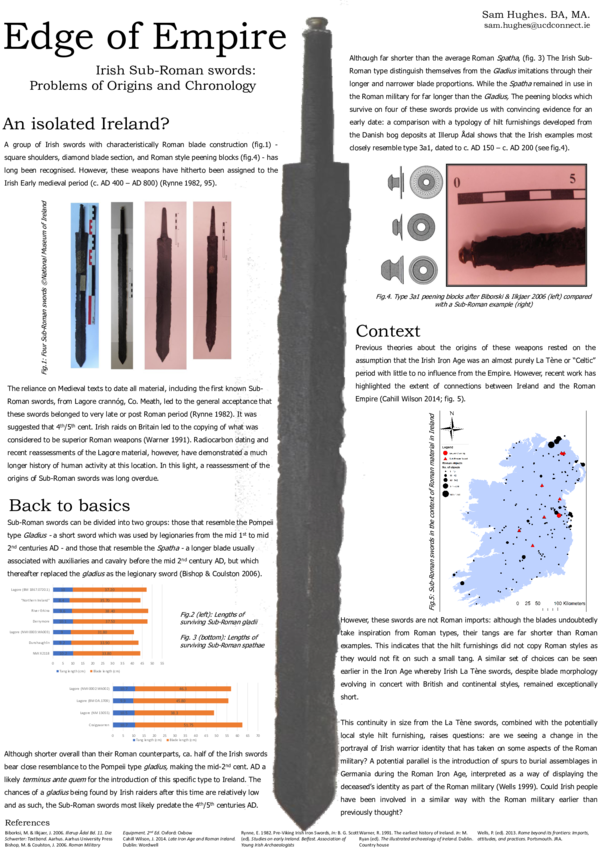Academia.edu no longer supports Internet Explorer.
To browse Academia.edu and the wider internet faster and more securely, please take a few seconds to upgrade your browser.
Sub-Roman Poster 2018
Sub-Roman Poster 2018
A group of Irish swords with Roman characteristics has been known to archaeologists since the early 20 th century but have always been considered Early Medieval due to a persistent perception that the Irish Iron Age was relatively untouched by the Roman Empire. Through a comparative study of Roman weapons in Britain and continental Europe, the research presented in this poster demonstrates that these swords are, in fact, likely to be derived from Early Imperial weapons. As such, the nature of contact with the Roman Empire and the meaning of these objects in an Irish context is also explored.
Related Papers
Iron Age swords are remarkable in terms of their short length compared to their contemporaries in La Tène Britain and Continental Europe, a feature that has led to speculation that they were primarily stabbing weapons or a ceremonial object not intended for fighting. This research incorporates previously published swords with new material from a survey of Irish museum databases to examine the swords in terms of blade morphology and dimension to infer their possible use in battle. The study shows that the majority of swords from the period (c. 700 BC – c. 400 AD), both La Tène and sub-Roman, have features of stabbing weapons used for fighting on foot. This is at odds with the nature of weaponry found elsewhere in La Tène Europe, and highlights an insular development in Ireland during the period. Through two case studies, this analysis also shows that in interacting with the outside world, conscious choices may have been made when it came to importing weapons and ideas. By clarifying the suggestions made in other works about the uses of these swords, this article looks at the swords from a new dimension, one that also relates these weapons to the nature of warfare and society in Iron Age Ireland.
Proceedings of the Royal Irish Academy
Irish medieval swords c.1170-16001986 •
A study of medieval swords known from Ireland between the late 12th and 16th centuries.
In an collection of papers dealing with the mechanics of use of weaponry in a combat environment from prehistory to the renaissance.
Warfare is increasingly considered to have been a major field of social activity in prehistoric societies, in terms of the infrastructures supporting its conduct, the effects of its occurrence, and its role in symbolic systems. In the Bronze Age many of the weapon forms that were to dominate battlefields for millennia to come were first invented — shields and swords in particular. Using the case study of Ireland, developments in Bronze Age warfare are traced from the Early to the Late Bronze Age. It is argued that during this period there was a move from warfare that made use of projectiles and impact weapons to warfare that used both defensive and cutting weapons. This formed the basis for a fundamental reorganisation in combat systems. This in turn stimulated change in the social organisation of warfare, including investment in material and training resources for warriors and the development of new bodily techniques reflecting fundamental changes in martial art traditions. Metalwork analysis of bronze weapons and experimental archaeology using replicas of these are used to support this position. The article explores how developments in fighting techniques transformed the sociality of violence and peer-relations among warriors and proposes that these warriors be regarded as a category of craft specialist exerting significant social influence by the Late Bronze Age.
This research assesses the archaeological and literary evidence regarding the significance of the early Medieval sword in Anglo-Saxon England. A dataset of 534 unique examples gathered from the Portable Antiquities Scheme and online Museum databases forms the basis of this analysis. Beginning with observing sword find locations within larger Anglo-Saxon England. An attempt is made to analyse where these examples are found in regards to known important settlements and battle locations with the aim of providing contemporary context and what these finds can say about the nature of early Medieval England. The second section deals with the perceived ‘other-worldly’ properties of the sword, as well as artistic design alongside function, providing a detailed analysis of art-styles found on fittings and average measurements for each type and component.
RELATED PAPERS
Prehistoric North Greece
Προϊστορική Βόρεια Ελλάδα [Prehistoric North Greece] 2η έκδ. 20242024 •
História Geral da África, vol. X: A África e suas Diásporas
Mann Castillo.Biografia historia e diaspora.PORT2023 •
Journal of investigational allergology & clinical immunology
Prevention of new sensitizations by specific immunotherapy in children with rhinitis and/or asthma monosensitized to house dust mite2007 •
Irish Historical Studies
Introduction – Ireland and Finland, 1860–1930: comparative and transnational histories2017 •
2018 •
Maǧallaẗ Kulliyyaẗ al-Adāb . Ġamiʿaẗ Beni-Sweif (2011) (Online)
Pronunciation Errors and Repair Strategies made by Northern Upper Egypt EFL Learners: A Case Study of the Production of English Sound Segments by First Year English Department Students in Beni-Suef University2020 •
The International Journal of Cardiovascular Imaging
How reliable are left ventricular ejection fraction cut offs assessed by echocardiography for clinical decision making in patients with heart failure?2012 •
Tentzonhuehue. El simbolismo del cuerpo y la naturaleza
Tentzonhuehue. El simbolismo del cuerpo y la naturaleza1998 •
Journal of Controlled Release
Controlled release of proteins from dextran hydrogels1996 •

 Sam Hughes
Sam Hughes